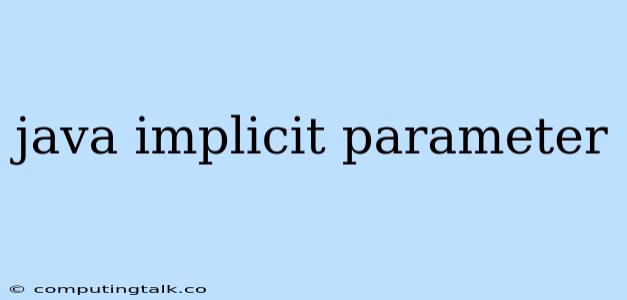Understanding Implicit Parameters in Java
Implicit parameters are a powerful feature in Java that simplifies code and enhances readability. They allow functions to access certain data without explicitly passing it as an argument. This concept, though subtle, can be a game-changer in terms of code organization and maintainability.
What are Implicit Parameters?
In essence, implicit parameters are values that are automatically available within a function's scope without the need to be explicitly passed as arguments. They are often referred to as "contextual" parameters, as their values are determined by the context in which the function is invoked.
Why Use Implicit Parameters?
Let's delve into the advantages of using implicit parameters:
-
Enhanced Code Readability: Explicitly passing common parameters repeatedly can clutter your code. Implicit parameters make your code cleaner by reducing redundancy.
-
Reduced Boilerplate: You don't need to explicitly pass values that are readily available within the context of the function call. This streamlines code and minimizes repetitive tasks.
-
Improved Code Organization: Implicit parameters facilitate a more organized code structure by encapsulating context-dependent data within the function's scope.
-
Flexibility and Reusability: Functions using implicit parameters can adapt to different contexts without needing to change their signature, promoting code reusability.
Common Implicit Parameters in Java
-
thisKeyword: In object-oriented programming, thethiskeyword acts as an implicit parameter, referring to the current instance of the class. -
Static Variables: Static variables are implicitly available to all methods within a class.
-
Method Parameters: While not explicitly passed, the arguments passed to a method are available within its scope as implicit parameters.
-
Enclosing Scope Variables: In nested methods, variables declared in the outer scope can be accessed implicitly.
Examples of Implicit Parameters in Java
1. Using this Keyword:
class Example {
int value;
void setValue(int newValue) {
this.value = newValue; // `this` implicitly refers to the current instance
}
}
In this example, this refers to the specific instance of the Example class on which the setValue method is called.
2. Using Static Variables:
class Counter {
static int count = 0;
void increment() {
count++; // Accessing the static variable implicitly
}
}
Here, count is a static variable that is shared by all instances of the Counter class. It is accessible implicitly within the increment method.
3. Enclosing Scope Variables:
class Outer {
int outerValue = 10;
class Inner {
void printValue() {
System.out.println(outerValue); // Implicit access to outerValue
}
}
}
In this nested class example, the Inner class's method has implicit access to the outerValue variable declared in the Outer class.
Best Practices for Using Implicit Parameters
-
Avoid Overuse: Implicit parameters should be used thoughtfully, not for passing arbitrary data.
-
Clarity and Documentation: Document the use of implicit parameters clearly for better code comprehension.
-
Maintain Code Readability: Strive for a balance between implicit parameter usage and code clarity.
Conclusion
Implicit parameters in Java are a powerful tool for streamlining code, enhancing readability, and promoting code reusability. By understanding their nature and advantages, you can leverage this feature effectively to write more maintainable and elegant Java programs. Remember to use them judiciously, prioritizing code clarity and minimizing ambiguity.
